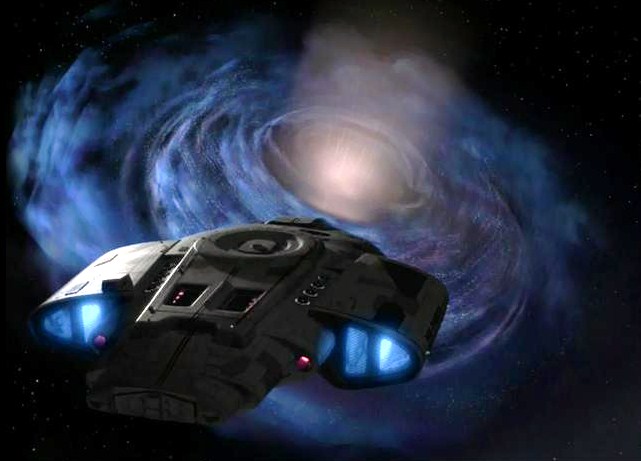
Science Fiction or Fact: Is Wormhole Space Travel Possible?

In this weekly series, Life's Little Mysteries explores the plausibility of popular science fiction concepts.
Sometimes warp speed just isn't an option. How, then, to traverse vast cosmic distances? Jump through a wormhole, of course.
These tunnels through space-time allow starships to zip across the galaxy in "Star Trek: Deep Space Nine" and form the alien transit hub seen in the 1997 movie "Contact."
For now, though, wormholes are merely a concept, and a highly speculative one at that. "The whole thing is very hypothetical at this point," said Stephen Hsu, a professor of theoretical physics at the University of Oregon. "No one thinks we’re going to find a wormhole anytime soon."
The ability to ever actually use wormholes as interstellar superhighways seems extremely remote. Yet physics does not close the door completely on the existence of these bridges through space-time.
Burrowing through spacetime
Wormholes have been bandied about by scientists for close to a century now. From a physics standpoint, a number of roads could lead to the creation of wormholes. One of the most explored is Albert Einstein's general theory of relativity. "There could be solutions to the Einstein equations which are wormholes," Hsu told Life's Little Mysteries.
Get the world’s most fascinating discoveries delivered straight to your inbox.
The solutions describe a "tube" through the four dimensions of space-time, potentially connecting two regions vast distances apart. Think of two dots on a sheet of paper that is then folded so the dots overlap. That overlap is your wormhole, and it could theoretically allow for the transfer of matter from dot A to dot B instantaneously, instead of traveling the normal, long way across the sheet.
Scientists have theorized how a wormhole might work. The "entrance" would be a black hole. Where matter "exits" from the wormhole would be, naturally, a white hole. The first half of that construction definitely exists: Black holes — hyperdense objects thought to be at the center of many galaxies, some of which are known to have formed during the collapse of giant stars — exert so much gravity that not even light can escape their clutches. [Slideshow: 6 Everyday Things That Happen Strangely in Space]
Although we cannot see black holes directly, we can infer their presence by how they affect nearby matter. Black holes have been caught in the act of gobbling up matter, which superheats as it swirls into their maws, and can routinely whip stars around the centers of galaxies where supermassive black holes reside.
There is zero observational evidence, however, for white holes, or matter otherwise materializing from the terminus of anything, let alone a wormhole.
It might be that we just can't see them: Wormholes may occur only on subatomic scales and last for mere fractions of a second, suggests Paul Davies, a theoretical physicist and cosmologist at the University of Arizona. "Wormholes large enough for a human being [to travel through] might require some new form of physics," Davies said.
A rough on ramp
Even supposing that nature somehow produced suitably person- or ship-size wormholes, passing through them would remain a tall order: The "strength" needed to open a passage through space-time, so far as we know, involves extreme densities and energies, conditions that would mean certain death to anyone entering a wormhole. [Can Anything Escape from a Black Hole?]
"If the formation of a black hole causes the formation of a wormhole which reconnects to our universe or another," Hsu said, "most of us would guess that the densities involved wouldn't be practically useful for someone soft and pink like you and me."
Wormhole engineering
That small matter aside, another issue for wormholes is keeping them pried open and stable. Many sorts of theoretical wormholes quickly collapse or scramble whatever particles are inside them.
"You would need some very exotic type of matter in order to stabilize a wormhole," said Hsu, "and it's not clear whether such matter exists in the universe."
Such matter would need to have negative energy that expands in space instead of contracting, as mass with its inherent gravity is wont to do. One such candidate phenomenon is the Casimir effect, which was verified about 15 years ago in the lab.
According to quantum mechanics, the vacuum of space is suffused by electromagnetic waves of all frequencies. By placing two thin metal plates within a few nanometers of each other, longer waves are excluded from the gap. Because there are not as many waves in the gap as in normal space, a negative energy density is created and the plates attract each other.
In theory, if amplified, the Casimir effect could be used to manipulate wormholes. But Hsu said the effect is very weak and would introduce the inherent, "fuzzy" unpredictability of quantum mechanical systems, so the wormhole would probably not be stabilized in any case.
Another strange item known as dark energy, the mysterious force thought to be behind the acceleration of the universe's expansion, hints at fresh physics yet to be understood. String theory and other corrections to general relativity might yet change the game, but Hsu said it is far from clear how any of these could be applied to the problem of wormhole wrangling.
Overall, exploiting natural wormhole portals or generating homemade versions, like the spacebridge in the film "Stargate," is far beyond our abilities. "You would need some of super-super-advanced technology," Hsu said. "Humans won't be doing this any time in the near future."
Plausibility score: Well-developed modern and speculative physics do not prohibit the existence of wormholes, but harnessing them for cosmic journeying would seem to require titanic breakthroughs in technology. We give wormholes one out of four possible Rocketboys.

Follow Life's Little Mysteries on Twitter @llmysteries, then join us on Facebook.

